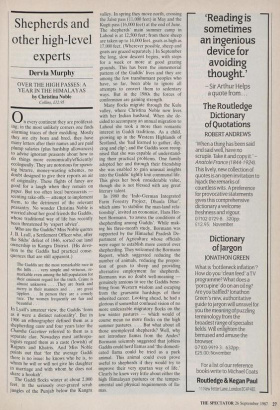Shepherds and other high-level experts
Deryla Murphy
OVER THE HIGH PASSES: A YEAR IN THE HIMALAYAS by Christina Noble Collins, £12.95 On every continent they are proliferat- ing; in the most unlikely corners one finds alarming traces of their meddling. Mostly they are city born and bred, they have many letters after their names and are paid plump salaries (plus hardship allowances) to advise ignorant peasants about how to do things more economically/efficiently/ ecologically. They are notorious for spawn- ing bizarre, money-wasting schemes, no doubt designed to give their reports an air of originality. These flights of fancy are good for a laugh when they remain on paper. But too often local bureaucrats scenting rake-offs — attempt to implement them, to the detriment of the relevant peasantry. No wonder Christina Noble is worried about her good friends the Gaddis, whose traditional way of life has recently been threatened by 'expert advice'. Who are the Gaddis? Miss Noble quotes 1. B. Lyall, a Settlement Officer who, after the Sikhs' defeat of 1846, sorted out land Ownership in Kangra District. (His devo- tion to the Gaddis had practical conse- quences that are still apparent.)
The Gaddis are the most remarkable race in the hills . . . very simple and virtuous, re- markable even among the hill population for their eminent regard for the truth. Crime is almost unknown . . . .They are frank and merry in their manners and . . . are great tipplers . . . In person they are a comely race. The women frequently are fair and beautiful . . .
In Lyall's amateur view, the Gaddis 'form as it were a distinct nationality'. But in 1906 an ethnographer defined them as a shepherding caste and four years later the Chamba Gazetteer referred to them as a separate clan. Nowadays most anthropo- logists regard them as a caste (lowish) of Rajputs and Khatris. And Miss Noble points out that 'for the average Gaddi there is no issue: he knows who he is, to whom he will or will not give his daughter in marriage and with whom he does not share a hookah'.
The Gaddi flocks winter at about 2,000 feet, in the seriously over-grazed scrub jungles of the Punjab below the Kangra valley. In spring they move north, crossing the Jalsti pass (11,000 feet) in May and the Kugti pass (16,000 feet) at the end of June, The shepherds' main summer camp in Lahoul is at 12,500 feet; from there sheep are taken up to 14,000 feet, goats as high as 17,000 feet. (Wherever possible, sheep and goats are grazed separately.) In September the long, slow descent begins, with stops for a week or more at good grazing grounds. This has been the immemorial pattern of the Gaddis' lives and they are among the few transhumant peoples who have, so far, been able to ignore all attempts to convert them to sedentary ways. But in the 1980s the forces of conformism are gaining strength.
Many flocks migrate through the Kulu valley, where Christina Noble now lives with her Indian husband. When she de- cided to accompany an annual migration to Lahoul she took a more than romantic interest in Gaddi traditions. As a child, growing up in the Western Highlands of Scotland, she tad learned to gather, dip, crog and clip'; and the Gaddis soon recog- nised that she was capable of understand- ing their practical problems. One family adopted her and through their friendship she was enabled to gain unusual insights into the Gaddis' tightly knit communal life. This gives her book considerable value, though she is not blessed with any great literary talent.
In 1980 the 'Indo-German Integrated Farm Forestry Project, Dhaula Dhar', which aims 'to stabilise the man-land rela- tionship', invited an economist, Hans Her- bert Bormann, 'to assess the conditions of shepherding among Gaddis'. While mak- ing his three-month study, Bormann was supported by the Himachal Pradesh De- partment of Agriculture whose officials were eager to establish more control over shepherding. They welcomed the Bormann Report, which suggested reducing the number of animals, reducing the propor- tion of goats to sheep and providing alternative employment for shepherds. Bormann was no doubt well-meaning genuinely anxious to see the Gaddis bene- fiting from Western wisdom and escaping from the gruesome hardships of their inherited career. Looking ahead, he had a glorious if somewhat confused vision of no more undesirable migratory flocks on the low winter pastures — which would of course mean no more flocks on the high summer pastures. . . . But what about all those unemployed shepherds? Well, why not introduce llamas from the Andes? Bormann solemnly suggested that jobless Gaddis could herd llamas and 'the domesti- cated llama could be tried as a pack animal. This animal could even prove useful to shepherds if they would try to improve their very spartan way of life.' Clearly he knew very little about either the high Himalayan pastures or the temper- amental and physical requirements of lla- mas.
Christina Noble, having lived and trek- ked with the Gaddis, is unsentimental about their way of life. It is rough and tough and some of the younger generation dream of city jobs. But their dreams are totally unrealistic. And shepherding is a lucrative occupation — incomparably more so than being a minor government official or under-employed university graduate. If the Gaddis were to abandon shepherding they would soon lose their present status as a proud, free people, enjoying an affluence that is hard-won but reliable. We must hope — Miss Noble is silent on this — that the Bormann Report has by now sunk to the bottom of some bureaucrat's filing cabinet. In India the 'man-land' rela- tionship is indeed important. Yet it cannot be 'stabilised' by impoverishing indi- vidualistic groups such as the Gaddis. That is Christina Noble's message and she deliv- ers it both forcefully and tactfully.































































 Previous page
Previous page